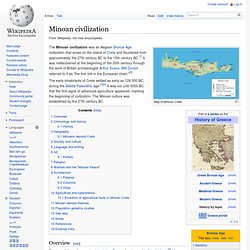

Histoire du parlement de paris, amiens. Summer of Love. Spring and Autumn Period. During the Spring and Autumn period, China's feudal system of fēngjiàn became largely irrelevant.

The Zhou dynasty kings held nominal power, but had real control over only a small royal demesne centered on their capital Luoyi[5] near modern-day Luoyang. During the early part of the Zhou dynasty period, royal relatives and generals had been given control over fiefdoms in an effort to maintain Zhou authority over vast territory.[6] As the power of the Zhou kings waned, these fiefdoms became increasingly independent states. The most important feudal princes (known later as the twelve vassals) met during regular conferences where important matters, such as military expeditions against foreign groups or offending nobles, were decided.
During these conferences, one vassal leader was sometimes declared hegemon (Chinese: 伯; pinyin: bó; later, Chinese: 霸; pinyin: bà) and given leadership over the armies of all Zhou states. Banquet of Chestnuts. The Banquet of Chestnuts, known more properly as the Ballet of Chestnuts, refers to a fête in Rome, and particularly to a supper held in the Papal Palace by Cardinal Cesare Borgia, son of Pope Alexander VI on 30 October 1501.
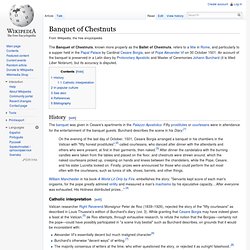
An account of the banquet is preserved in a Latin diary by Protonotary Apostolic and Master of Ceremonies Johann Burchard (it is titled Liber Notarum), but its accuracy is disputed. Heritage History presents The Story of Modern France by Helene Guerber. Augur. Anthony Blunt. Anthony Frederick Blunt (26 September 1907 – 26 March 1983),[1] known as Sir Anthony Blunt, KCVO from 1956 to 1979, when he was stripped of his honours, was a British art historian who was exposed as a Soviet spy late in his life.

Blunt was Professor of the History of Art at the University of London, director of the Courtauld Institute of Art, Surveyor of the King's Pictures in London. He was exposed as a member of the Cambridge Five, a group of spies working for the Soviet Union from some time in the 1930s to at least the early 1950s. Early life[edit] Congresul Partidului Comunist al Uniunii Sovietice. Congresul Partidului Comunist al Uniunii Sovietice era cea mai înaltă instanță de conducere a Partidului Comunist (și a predecesorilor lui).
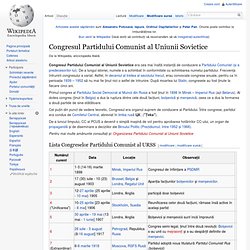
De-a lungul istoriei, numele s-a schimbat în conformitate cu schimbarea numelui partidului. Frecvența întrunirii congresului a variat. Astfel, în deceniul al treilea al secolului trecut, erau convocate congrese anuale, pentru ca în perioada 1939 – 1952 să nu mai fie ținut nici o astfel de întrunire. După moartea lui Stalin, congresele au fost ținute la fiecare cinci ani. Primul congres al Partidului Social Democrat al Muncii din Rusia a fost ținut în 1898 în Minsk – Imperiul Rus (azi Belarus). Cel puțin din punct de vedere teoretic, Congresul era organul suprem de conducere al Partidului. De-a luncul timpului, CC al PCUS a devenit o simplă mașină de vot pentru aprobarea hotăririlor CC-ului, un organ de propagandă și de diseminare a deciziilor ale Biroului Politic (Prezidiumul, între 1952 și 1966).
[modificare | modificare sursă] South Africa under apartheid. Racial segregation in South Africa began in colonial times under Dutch rule.[6] Apartheid as an official policy was introduced following the general election of 1948.
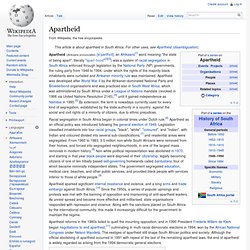
Legislation classified inhabitants into four racial groups, "black", "white", "coloured", and "Indian", with Indian and coloured divided into several sub-classifications,[7] and residential areas were segregated. From 1960 to 1983, 3.5 million non-white South Africans were removed from their homes, and forced into segregated neighbourhoods, in one of the largest mass removals in modern history.[8] Non-white political representation was abolished in 1970, and starting in that year black people were deprived of their citizenship, legally becoming citizens of one of ten tribally based self-governing homelands called bantustans, four of which became nominally independent states.
Romulus and Remus. Capitoline Wolf.
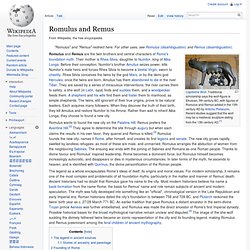
Traditional scholarship says the wolf-figure is Etruscan, 5th century BC, with figures of Romulus and Remus added in the 15th century AD by Antonio Pollaiuolo. Recent studies suggest that the wolf may be a medieval sculpture dating from the 13th century AD.[1] Romulus wants to found the new city on the Palatine Hill; Remus prefers the Aventine Hill.[2] They agree to determine the site through augury but when each claims the results in his own favor, they quarrel and Remus is killed.[3] Romulus founds the new city, names it Rome, after himself, and creates its first legions and senate.
Estimated IQs of the Greatest Geniuses. (created: 04/21/1998) (maintenance: 01/17/2005) This page is dedicated to some of the greatest minds of all time. A normal intelligence quotient (IQ) ranges from 85 to 115 (According to the Stanford-Binet scale). Minoan civilization. Map of Minoan Crete The Minoan civilization was an Aegean Bronze Age civilization that arose on the island of Crete and flourished from approximately the 27th century BC to the 15th century BC.[1] It was rediscovered at the beginning of the 20th century through the work of British archaeologist Arthur Evans.
